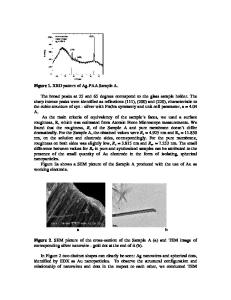Synthesis, Characterization, and Growth Mechanism of Silicon Oxide Nanowires
- PDF / 571,873 Bytes
- 6 Pages / 612 x 792 pts (letter) Page_size
- 66 Downloads / 324 Views
Z10.9.1
Synthesis, Characterization, and Growth Mechanism of Silicon Oxide Nanowires Lifeng Dong, Michael Coulter 1, Neil Ford 2 and Jun Jiao Department of Physics, Portland State University, Portland, OR 97201 1
Harvard University, Cambridge, MA 02138
2
Department of Chemical Engineering, Oregon State University, Corvallis, OR 97331
ABSTRACT Two fabrication methods have been investigated to synthesize silicon oxide nanowires. One was catalytic thermal evaporation method in which silicon monoxide was used as the precursor and Au particles served as the catalysts. Using nanosphere lithography, patterned nanowires were obtained and their growth positions were controlled by the locations of Au catalysts. For the second method, without silicon monoxide as the precursor and without the aid of Au catalyst, silicon oxide nanowires directly formed along the direction of the silicon substrate only with the introduction of hydrogen gas. A series of experiments were carried out to study effects of reaction time, temperature, and hydrogen on the growth of the nanowires. Also, various electron microscopy techniques were utilized to characterize their morphologies and internal structures and to analyze their compositional distributions. In this paper, the characterization of different silicon oxide nanowires and their formation mechanisms in relation to both preparation methods are discussed. INTRODUCTION Due to their unique optical and dielectric properties, silicon oxide nanowires have been investigated as the building blocks for nanoscale blue light-emitting diodes and electronic devices [1-3]. However, to understand the novel optoelectronic and electronic properties of silicon oxide at nanoscale dimensions, it is important to be able to synthesize silicon oxide nanowires with controlled morphologies and growth positions. Therefore, in this paper, a nanosphere lithography method was investigated to grow patterned silicon oxide nanowires. In addition, a novel method, hydrogen induced oxygen diffusion, was explored to synthesize silicon oxide nanowires without the presence of any catalysts and precursors. To study the growth thermodynamics and kinetics of the oxide nanowires, a series of experiments was systematically carried out and high resolution transmission electron microscopy (HRTEM) and scanning electron microscopy (SEM) were utilized to study their internal structures, morphologies and composition distributions. Based on the results of electron microscopy characterization, some growth mechanisms are proposed to explain their growth processes. EXPERIMENTAL DETAILS Patterned growth of SiOx nanowires via nanosphere lithography In comparison to photolithography and electron beam lithography processes, nanosphere lithography is a simple and cost-effective method for patterned metal deposition [4]. Thus, in this
Z10.9.2
study, nanosphere lithography was investigated for the patterned deposition of Au catalysts. First, several drops of latex polystyrene nanosphere solution (8%, average diameter: 540 nm, Interfacial Dyna
Data Loading...





